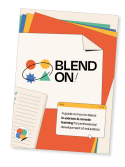Evaluate
The analysis, design, development, and implementation of blended continuous professional development (CPD) requires significant time and resources. Whether you are a CPD provider, a facilitator, or a member of the design team, you and your stakeholders want to know if your CPD is effective and why (or why not). Often, you also want to know if it was cost-effective and worth the investment of resources.
An evaluation will help decision makers determine whether the results and outcomes of the conducted blended CPD warrant further investment to continue, scale or expand, or whether it is better to discontinue efforts and try a new approach. In addition, an evaluation should allow you to evaluate if the blended approach was the best ‘fit for purpose’, if it was inclusive, engaging and motivating.
Evaluation is an ongoing process in developing a blended CPD trajectory.
Step 1
Define the objective and focus of your evaluation
First, it is important that you have a clear understanding of what success looks like. One commonly used model is Guskey’s Model, which has five levels of evaluating professional learning: (1) participants’ reactions, (2) participants’ learning, (3) organisational support and change, (4) participants’ use of new knowledge and skills and (5) student learning outcomes. These levels build on one another. In addition to evaluating effectiveness, you can also assess if the blended CPD trajectory is cost-effective, inclusive, and sustainable. To ensure a thorough evaluation, you should meet with the design and evaluation teams to establish your evaluation objectives and questions. Use the available tool to formulate a set of evaluation questions, matched with Guskey’s evaluation levels.
Step 2
Collect evaluation data
Second, to get the information you need, think carefully about what you want to learn and choose the right data collection methods, whether that’s through surveys, interviews, or other methods. When collecting data, think about what information already exists and what data you need to collect to meet your evaluation goals, keeping your participants’ privacy and data security in mind. To do this, it’s a good idea to have policies and standards in place to protect sensitive information and follow data protection laws in your area.
Step 3
Analyse, interpret and learn from the data
Third, you’ll need to organise and prepare your collected data for use. This includes categorising, coding and presenting it in a useful way for analysis and interpretation. Then, you’ll choose your analytical approach based on the type of data you have and the frequency of data collection. The next step is data interpretation and learning, which involves relevant stakeholders and provides an opportunity to bring different perspectives and experiences. Dissemination and communicating your findings are important for take-up among stakeholders. It’s recommended to use ICT to collect, analyse and disseminate data and insights, as it’s more efficient, cost-effective and flexible. Blended CPD offers the opportunity to collect a lot of data on participation, engagement and progress. This allows for shorter feedback loops and learning.
Take a few minutes to check up on your progress in this phase of your blended CPD trajectory by reviewing our checklist.
In Practice
Here you can find all good practices discussed in this phase.
Subscribe to newsletter

Download our guide for a more in-depth and comprehensive look at developing a successful blended CPD programme.
© Copyright 2023 VVOB - vvob.org
